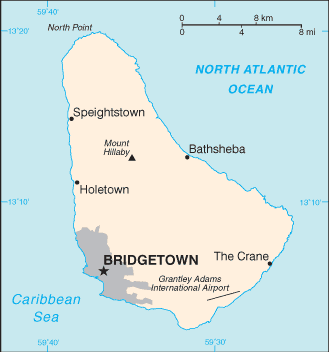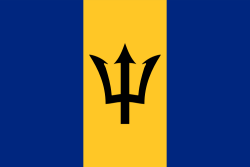Barbados
Related Categories:
 Government of Barbados - National Flag
Government of Barbados - National FlagThe symbol in the centre panel is the Trident of the Mythical sea god Neptune.
barbados.gov.bb/
The two lateral prongs, sharpened on one side only, symbolize the ascending and descending paths between the celestial and terrestrial worlds.
users.skynet.be/
National Flag, Coat of Arms, and other Flags.
www.fotw.us/
Barbados has one of the highest standards of living and literacy rates in the developing world.
en.wikipedia.org/
People
About 90% of Barbados' population is of African descent, 4% European descent, and 6% Asian or mixed. About 40% of Barbadians are Anglican, and the rest mostly Roman Catholic, Methodist, Baptist, and Moravian. There also are small Jewish and Muslim communities. Barbados' population growth rate has been very low, less than 1% since the 1960s, largely due to family planning efforts and a high emigration rate.
Economy
Since independence, Barbados has transformed itself from a low-income economy dependent upon sugar production into an upper-middle-income economy based on tourism. Barbados is now one of the most prosperous countries in the western hemisphere outside of the U.S. and Canada. The economy went into a deep recession in 1990 after 3 years of steady decline brought on by fundamental macroeconomic imbalances. After a painful readjustment process, the economy began to grow again in 1993. Growth rates averaged between 3%-5% since then until 2001, when the economy contracted 2.8% in the wake of the September 11 terrorist attacks and the global drop-off in tourism. Growth picked up again in 2003, and the economy grew by 3.4% in 2004, and by 4.1% in 2005.
Tourism drives the economy in Barbados, but offshore banking and financial services have become an increasingly important source of foreign exchange and economic growth. The sugar industry, once dominant, now makes up approximately 1% of GDP and employs only around 500 people. The labor force totaled 145,800 persons at the end of 2005. The average rate of unemployment for the first quarter of 2006 was estimated at 8.1%.
Barbados will host several games and the final of the Cricket World Cup in 2007, and much of the country's investment is directed toward accommodating the expected influx of visitors. The government and private sector are both working to prepare the country for the CARICOM Single Market and Economy (CSME)--a European Union-style single market.
www.state.gov/r/
Introduction
About
Contact
Symbols in The News
Interpret this Symbol
AAC
African
AI
Alchemy
Alphabets
Ancient
Animal Symbolism
Architecture
Art
Articles
Astrology
Baha'i
Blissymbolics
Blueprint Symbols
Buddhist
Celtic Symbols
Cemetery
Chinese Symbols
Christian
Circle
City
Codes
Color
Conlangs
Crop Circles
Danger
Da Vinci Code
Designing Logos
Dictionaries
Dreams
Education
Egyptian Symbols
Electrical
Emoticons
Find Images
Fonts
Food
Fraternity
Hamsa
Healing
Heraldry
Hermetic
Highway Signs
Hindu
History
Hobo
Holiday
Icons
iConji
Islamic
Jain Symbols
Japanese, Kanji
Jewish
Justice
Law
Literary Symbolism
Mandalas
Map
Masonic
Math, Number
Meaning of Names
Medical
Middle East
Military
Miscellaneous
Money
Music
Mythology
Native American
Playing Cards
Power
Psychology
QiQiiKhu
Reiki
Religious
Runes, Norse
Sacred Geometry
Scientific
Science Fiction
Sorority
Sports
Symbols in the News
Tattoos
ThirteenSymbols
Tree of Life
Ursprache
Videos
Visual Languages
Weather
Web Codes
Wicca
Words
Writing Systems
Braille
Coinherence
Coptic
Cuneiform
Easter Island
Etruscan
Happy Human
Hebrew
Kokopelli
Linear B
Lotus
Love Symbols
Mandorla
Moon Alphabet
Nine Pointed Star
Om
Oz
Phonetic
Scarab Beetle
Silent
Theosophy
Unifon
About
Contact
Symbols in The News
Interpret this Symbol
AAC
African
AI
Alchemy
Alphabets
Ancient
Animal Symbolism
Architecture
Art
Articles
Astrology
Baha'i
Blissymbolics
Blueprint Symbols
Buddhist
Celtic Symbols
Cemetery
Chinese Symbols
Christian
Circle
City
Codes
Color
Conlangs
Crop Circles
Danger
Da Vinci Code
Designing Logos
Dictionaries
Dreams
Education
Egyptian Symbols
Electrical
Emoticons
Find Images
Fonts
Food
Fraternity
Hamsa
Healing
Heraldry
Hermetic
Highway Signs
Hindu
History
Hobo
Holiday
Icons
iConji
Islamic
Jain Symbols
Japanese, Kanji
Jewish
Justice
Law
Literary Symbolism
Mandalas
Map
Masonic
Math, Number
Meaning of Names
Medical
Middle East
Military
Miscellaneous
Money
Music
Mythology
Native American
Playing Cards
Power
Psychology
QiQiiKhu
Reiki
Religious
Runes, Norse
Sacred Geometry
Scientific
Science Fiction
Sorority
Sports
Symbols in the News
Tattoos
ThirteenSymbols
Tree of Life
Ursprache
Videos
Visual Languages
Weather
Web Codes
Wicca
Words
Writing Systems
Braille
Coinherence
Coptic
Cuneiform
Easter Island
Etruscan
Happy Human
Hebrew
Kokopelli
Linear B
Lotus
Love Symbols
Mandorla
Moon Alphabet
Nine Pointed Star
Om
Oz
Phonetic
Scarab Beetle
Silent
Theosophy
Unifon

